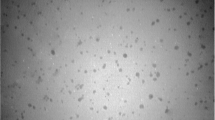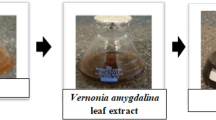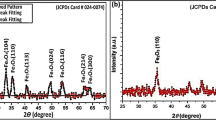Abstract
The application of zero-valent iron nanoparticles (nZVI) is an area of growing interest, especially in the remediation processes of waters of different origin. The standard synthetic procedure for nZVI involves the chemical reduction of Fe2+ or Fe3+ with the solution of a strong reducing agent. This type of synthetic route leads to the formation of new toxic species. The green synthesis of nZVI using plant extracts is, therefore, an excellent alternative to the above-mentioned conventional methods. Within the scope of this work, the amorphous nZVI was synthesized by green tea mediated single-step method from Fe3+ as precursors, denoting an eco-friendly approach. Additionally, the physico–chemical characterization (TEM, SEM/EDS, size of particles/aggregates, XRD, BET) of nZVI was performed. The catalytic activity of the obtained nZVI was tested in a Fenton-like reaction of the removal/degradation of three representative industrial textile dyes (methylene blue, methyl orange and bromothymol blue) from water. In order to optimize the process parameters, the effect of homogenization treatment, nZVI and H2O2 concentration on catalytic performance were also done followed by degradation kinetic study using four different models. The results of this work have shown the exceptionally high efficiency of the green nZVI which is reflected in almost complete degradation of all tested dyes within very short period of time, despite their amorphous nature, aggregates arrangement and very low specific surface area. Furthermore, the examined degradation kinetics has excellently followed the BMG model, indicating that the degradation process of the investigated dyes proceeds via two stages (two-stage pattern)—a fast one and a much slower one, regardless of the used reaction conditions. Based on all gained results, particular degradation mechanisms were proposed.
Graphical Abstract









Similar content being viewed by others
References
Galdames A, Ruiz-Rubio L, Orueta M, Sánchez-Arzalluz M, Vilas-Vilela JL (2020) Zero-valent iron nanoparticles for soil and groundwater remediation. Int J Environ Res Public Health 17:5817
Crane RA, Scott TB (2012) Nanoscale zero-valent iron: future prospects for an emerging water treatment technology. J Hazard Mater 211–212:112–125
Lye JWP, Saman N, Noor AMM, Mohtar SS, Othman NS, Sharuddin SSN, Kong H, Mat H (2020) Application of nanoscale zero-valent iron-loaded natural zeolite for tetracycline removal process. Chem Eng Technol 43(7):1285–1296
Mondal P, Anweshan A, Purkait MK (2020) Green synthesis and environmental application of iron-based nanomaterials and nanocomposite: a review. Chemosphere 259:127509
Le NT, Dang T-D, Binh KH, Nguyen TM, Xuan TN, La DD, Nadda AK, Chang SW, Nguyen DD (2022) Green synthesis of highly stable zero-valent iron nanoparticles for organic dye treatment using Cleistocalyxoperculatus leaf extract. Sustain Chem Pharm 25:100598
Liang L, Tan W, Xue Y, Xi F, Meng X, Hu B, Du J (2022) Effects of magnetic field on selenite removal by sulfidated zero valent iron under aerobic conditions. Sci Total Environ 831:154755
Wang CB, Zhang WX (1997) Synthesizing nanoscale iron particles for rapid and complete dechlorination of TCE and PCBs. Environ Sci Technol 31:2154–2156
O’Caroll D, Sleep B, Krol M, Boparai H, Kocur C (2013) Nanoscale zero-valent iron and bimetallic particles for contaminated site remediation. Adv Water Res 51:104–122
Ravikumar KVG, Dubey S, Chandrasekaran N, Mukherjee A (2016) Scale-up synthesis of zero-valent iron nanoparticles and their applications for synergistic degradation of pollutants with sodium borohydride. J Mol Liq 224:589–598
Danila V, Vasarevicius S, Valskys V (2018) Batch removal of Cd(II), Cu(II), Ni(II), and Pb(II) ions using stabilized zero-valent iron nanoparticles. Energy Proc 147:214–219
Zhou N, Gong K, Hu Q, Cheng X, Zhou J, Dong M, Wang N, Ding T, Qiu B, Guo Z (2020) Optimizing nanocarbon shell in zero-valent iron nanoparticles for improved electron utilization in Cr(VI) reduction. Chemosphere 242:125235
Fu F, Dionysiou DD, Liu H (2014) The use of zero-valent iron for groundwater remediation and wastewater treatment: a review. J Hazard Mater 267:194–205
Stefaniuk M, Oleszczuk P, Ok YS (2016) Review on nano zero-valent iron (nZVI): from synthesis to environmental applications. Chem Eng J 287:618–632
Machado S, Stawiński W, Slonina P, Pinto AR, Grosso JP, Nouws HPA, Albergaria JT, Delerue-Matos C (2013) Application of green zero-valent iron nanoparticles to the remediation of soils contaminated with ibuprofen. Sci Total Environ 461–462:323–329
Demirezen DA, Yildtz YS, Yilmaz S, Yilmaz D (2019) Green synthesis and characterization of iron oxide nanoparticles using Ficuscarica (common fig) dried fruit extract. J Biosci Bioeng 127:241–245
Karpagavinayagam P, Vedhi C (2019) Green synthesis of iron oxide nanoparticles using Avicennia marina flower extract. Vacuum 160:286–292
Mareedu T, Poiba VR, Vangalapati M (2021) Green synthesis of iron nanoparticles by green tea and black tea leaves extract. Mater Today Proc 42:1498–1501
Machado S, Pacheco JG, Nouws HPA, Albergaria JT, Delerue-Matos C (2013) Characterization of green zero-valent iron nanoparticles produced with tree leaf extracts. Sci Total Environ 533:76–81
Hoag GE, Collins JB, Holcomb JL, Hoag JR, Nadagouda MN, Varma RS (2009) Degradation of bromothymol blue by ‘greener’ nanoscale zero-valent iron synthesized using tea polyphenols. J Mater Chem 19:8671–8677
Babuponnusami A, Muthukumar K (2014) A review on Fenton and improvements to the Fenton process for wastewater treatment. J Environ Chem Eng 2:557–572
Maroudas A, Pandis PK, Chatzopoulou A, Davellas L-R, Sourkouni G, Argirusis C (2021) Synergetic decolorization of azo dyes using ultrasounds, photocatalysis and photo-fenton reaction. Ultrason Sonochem 71:105367
Wang N, Zheng T, Zhang G, Wang P (2016) A review on Fenton-like processes for organic wastewater treatment. J Environ Chem Eng 4:762–787
Genuino HC, Mazrui N, Seraji MS, Luo Z, Hoag GE (2013) Green synthesis of iron nanomaterials for oxidative catalysis of organic environmental pollutants. In: Suib SL (ed) New and future developments in catalysis. Elsevier, Amsterdam, pp 41–61
Raman CD, Konmani S (2016) Textile dye degradation using nano zero valent iron. J Environ Manag 177:341–355
Huang L, Weng X, Chen Z, Megharaj M, Naidu R (2014) Green synthesis of iron nanoparticles by various tea extracts: comparative study of the reactivity. Spectrochim Acta Part A 130:295–301
Wang X, Wang A, Ma J, Fu M (2017) Facile green synthesis of functional nanoscale zero-valent iron and studies of its activity toward ultrasound-enhanced decolorization of cationic dyes. Chemosphere 166:80–88
He Y, Gao J, Feng F, Liu C, Peng Y, Wang S (2012) The comparative study on the rapid decolorization of azo, anthraquinone and triphenylmethane dyes by zero-valent iron. Chem Eng J 179:8–18
Kuang Y, Wang Q, Chen Z, Megharaj M, Naidu R (2013) Heterogeneous Fenton-like oxidation of monochlorobenzene using green synthesis of iron nanoparticles. J Coll Inter Sci 410:67–73
Puiatti GA, de Carvalho JP, de Matos JP, Lopes RP (2022) Green synthesis of Fe0 nanoparticles using Eucalyptus grandisleaf extract: characterization and application for dye degradation by a (Photo) Fenton-like process. J Environ Manag 311:114828
Jain R, Mendiratta S, Kumar L, Srivastava A (2021) Green synthesis of iron nanoparticles using Artocarpus heterophyllus peel extract and their application as a heterogeneous Fenton-like catalyst for the degradation of Fuchsin Basic dye. Curr Res Green Sustain Chem 4:100086
Truskewycz A, Shukla R, Ball AS (2016) Iron nanoparticles synthesized using green tea extracts for the fenton-like degradation of concentrated dye mixtures at elevated temperatures. J Environ Chem Eng 4:4409–4417
Njagi EC, Huang H, Stafford L, Genuino H, Galindo HM, Collins JB, Hoag GE, Suib SL (2011) Biosynthesis of iron and silver nanoparticles at room temperature using aqueous Sorghum bran extracts. Langmuir 27:264–271
Shahwan T, Sirriah SA, Nairat M, Boyac E, Eroğlu AE, Scott TB, Hallam KR (2011) Green synthesis of iron nanoparticles and their application as a Fenton-like catalyst for the degradation of aqueous cationic and anionic dyes. Chem Eng J 172:258–266
Arancibia-Miranda N, Baltazar SE, Garcia A, Romero AH, Rubio MA, Altbir D (2014) Lead removal by nano-scale zero valent iron: surface analysis and pH effect. Mater Res Bull 59:341–348
Zha SX, Cheng Y, Gao Y, Chen ZL, Megharaj M, Naidu R (2014) Nanoscale zerovalent iron as a catalyst for heterogeneous Fenton oxidation of amoxicillin. Chem Eng J 255:141–148
Wang T, Jin X, Chen Z, Megharaj M, Naidu R (2014) Green synthesis of Fe nanoparticles using eucalyptus leaf extracts for treatment of eutrophic wastewater. Sci Total Environ 466–467:210–213
Lowell S, Shields JE, Thomas MA, Thommes M (2004) Characterization of porous solids and powders: surface area, pore size and density, vol 16. Kluwer Academic Publishers, Dordrecht
Kuo WG (1992) Decolorizing dye wastewater with Fenton’s reagent. Water Res 26:881–886
Lin J, Zhao X, Liu D, Yu Z, Zhang Y, Xu H (2008) The decoloration and mineralization of azo dye C.I. Acid Red 14 by sonochemical process: rate improvement via Fenton’s reactions. J Hazard Mater 157:541–546
Weng C, Huang V (2015) Application of Fe0 aggregate in ultrasound enhanced advanced Fenton process for decolorization of methylene blue. J Ind Eng Chem 28:153–160
Yuan N, Zhang G, Guo S, Wan Z (2016) Enhanced ultrasound-assisted degradation of methyl orange and metronidazole by rectorite-supported nanoscale zero-valent iron. Ultrason Sonochem 28:62–68
Weng C, Lin Y, Chang C, Liu N (2013) Decolourization of direct blue 15 by Fenton/ultrasonic process using a zero-valent iron aggregate catalyst. Ultrason Sonochem 20:970–977
Singhal GS, Rabinowitch E (1967) Changes in the absorption spectrum of methylene blue with pH. J Phys Chem 71:3347–3349
Fan J, Guo Y, Wang J, Fan M (2009) Rapid decolorization of azo dye methyl orange in aqueous solution by nanoscale zero-valent iron particles. J Hazard Mater 166:904–910
Dong H, Sans C, Li W, Qiang Z (2016) Promoted discoloration of methyl orange in H2O2/Fe(III) Fenton system: effects of gallic acid on iron cycling. Separ Purif Tech 171:144–150
Tarekegn MM, Balakrishnan RM, Hiruya AM, Dekeboa AH (2021) Removal of methylene blue dye using nano zerovalent iron, nanoclay and iron impregnated nanoclay—a comparative study. RSC Adv 11:30109
Holčapek M, Volná K, Vaněrková D (2007) Effects of functional groups on the fragmentation of dyes in electrospray and atmospheric pressure chemical ionization mass spectra. Dyes Pigm 75:156–165
Chen T, Zheng Y, Lin J-M, Chen G (2008) Study on the photocatalytic degradation of methyl orange in water using Ag/ZnO as catalyst by liquid chromatography electrospray ionization ion-trap mass spectrometry. J Am Soc Mass Spectrom 19:997–1003
Behnajady MA, Modirshahla N, Ghanbary F (2007) A kinetic model for the decolorization of C.I. Acid Yellow 23 by Fenton process. J Hazard Mater 148:98–102
Haji S, Khalaf M, Shukrallah M, Abdullah J, Ahmed S (2014) A kinetic comparative study of azo dye decolorization by catalytic wet peroxide oxidation using Fe–Y zeolite/H2O2 and photooxidation using UV/H2O2. React Kinet Mech Catal 114:795–815
Roumila Y, Meziani D, Debaghi S, Abdmeziem K (2021) Degradation of methyl violet over fenton-like hydroxyapatite catalysts, kinetics and thermodynamics studies. Res Square. https://doi.org/10.21203/rs.3.rs-569149/v1
Acknowledgements
The authors acknowledge the financial support of the Ministry of Education, Science, and Technological Development of the Republic of Serbia (Grant Nos. 451-03-68/2022-14/200134, 451-03-68/2022-14/200125 and 451-03-68/2022-14/200133). We are also grateful to Nada Popsavin for Figures processing.
Author information
Authors and Affiliations
Corresponding author
Ethics declarations
Competing interests
The authors declare that they have no known competing financial interests or personal relationships that could have appeared to influence the work reported in this paper.
Additional information
Publisher's Note
Springer Nature remains neutral with regard to jurisdictional claims in published maps and institutional affiliations.
Supplementary Information
Below is the link to the electronic supplementary material.
Rights and permissions
Springer Nature or its licensor (e.g. a society or other partner) holds exclusive rights to this article under a publishing agreement with the author(s) or other rightsholder(s); author self-archiving of the accepted manuscript version of this article is solely governed by the terms of such publishing agreement and applicable law.
About this article
Cite this article
Panić, S., Petronijević, M., Vukmirović, J. et al. Green Synthesis of Nanoscale Zero-Valent Iron Aggregates for Catalytic Degradation of Textile Dyes. Catal Lett 153, 3605–3619 (2023). https://doi.org/10.1007/s10562-022-04257-z
Received:
Accepted:
Published:
Issue Date:
DOI: https://doi.org/10.1007/s10562-022-04257-z




